 W
WAnderella is a genus of synziphosurine, a paraphyletic group of fossil chelicerate arthropods. Anderella was regarded as part of the clade Prosomapoda. Fossils of the single and type species, A. parva, have been discovered in deposits of the Carboniferous period in Montana, in the United States. Anderella is the first and so far the only Carboniferous synziphosurine being described, making it the youngest member of synziphosurines. Anderella is also one of the few synziphosurine genera with fossil showing evidence of appendages, but the details are obscure due to their poor preservation.
 W
WAustrodecidae is a family of sea spiders. Austrodecidaes tend to be small measuring only 1–2 mm. This family is polyphyletic and will be split into two groups.
 W
WAustrolimulus fletcheri is an extinct xiphosuran, related to the modern horseshoe crab. The holotype and only known specimen is from Middle Triassic-aged strata of Brookvale, New South Wales of Australia.
 W
WBembicosoma is a genus of synziphosurine, a paraphyletic group of fossil chelicerate arthropods. Bembicosoma was regarded as part of the clade Planaterga. Fossils of the single and type species, B. pomphicus, have been discovered in deposits of the Silurian period in the Pentland Hills, Scotland. Bembicosoma had been tentatively assigned as an eurypterid before its synziphosurine affinities revealed.
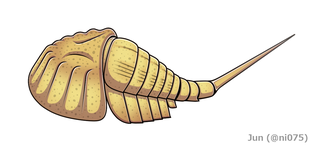 W
WBunodes is a genus of synziphosurine, a paraphyletic group of fossil chelicerate arthropods. Bunodes was regarded as part of the clade planaterga. Fossils of the single and type species, B. lunula, have been discovered in deposits of the Silurian period in Ludlow, England. Bunodes is the type genus of the family Bunodidae, the other genera of the same family being Limuloides.
 W
WBunodidae is an extinct family of synziphosurine chelicerates that lived in the Silurian. Bunodidae is classified inside the clade Planaterga alongside Pseudoniscidae and Dekatriata. Bunodidae is composed by two genera, Bunodes and Limuloides.
 W
WCallipallene is a genus of sea spiders in the family Callipallenidae. There are more than 30 described species in Callipallene.
 W
WCallipallene brevirostris is a species of sea spider in the family Callipallenidae. It is found in Europe.
 W
WCallipallenidae is a family of Sea spider.
 W
WCamanchia is a genus of synziphosurine, a paraphyletic group of fossil chelicerate arthropods. Camanchia was regarded as part of the clade Prosomapoda. Fossils of the single and type species, C. grovensis, have been discovered in deposits of the Silurian period in Iowa, in the United States. Alongside Venustulus, Camanchia is one of the only Silurian synziphosurine with fossil showing evidence of appendages.
 W
WChasmataspis is a genus of chasmataspidid, a group of extinct aquatic arthropods.
 W
WColossendeis colossea is a species of sea spider in the family Colossendeidae. The species was first described by Wilson in 1881.
 W
WCyamocephalus is a genus of synziphosurine, a paraphyletic group of fossil chelicerate arthropods. Cyamocephalus was regarded as part of the clade Planaterga. Fossils of the single and type species, C. loganensis, have been discovered in deposits of the Silurian period in Lesmahagow, Scotland. Cyamocephalus is one of the two members of the family Pseudoniscidae, the other being Pseudoniscus. Cyamocephalus differ from Pseudoniscus by the fused tergites of 6th and 7th opisthosomal segments.
 W
WDekatriata is a clade of planatergan chelicerates including the groups Arachnida, Chasmataspidida, Eurypterida and additionally two stem-genera Winneshiekia and Houia. Dekatriata is defined by an opisthosoma with 13 segments as groundplan and fused, plate-like appendages on the first opisthosomal segment.
 W
WDibasterium is an extinct genus of euchelicerate, a group of chelicerate arthropods. Fossils of the single and type species, D. durgae, have been discovered in deposits of the Middle Silurian period in Herefordshire, England. The name of the genus is derived from the Latin words dibamos and mysterium ("mystery"), meaning "mystery on two legs" and referring to its prosomal limbs. The species name durgae comes from Durga, a Hindu goddess with many arms.
 W
WHoplitaspis is a genus of chasmataspidid, an extinct group of aquatic arthropods. Fossils of Hoplitaspis have been discovered in Late Ordovician deposits of the Lagerstätte of the Big Hill Formation exposed at Stonington Peninsular in Michigan's Upper Peninsula, United States. Its generic name is derived from the hoplites and the Ancient Greek word άσπίς. The specific name hiawathai honors Hiawatha, a Native American leader and co-founder of the Iroquois Confederacy.
 W
WHouia is a genus of dekatriatan, a clade of chelicerate arthropods. Fossils of the single and type species, H. yueya, have been discovered in deposits of the Early Devonian period in Yunnan, China. The name of the genus is derived from the Chinese character 鲎 (hòu), meaning "horseshoe crab". The species name yueya comes from the Chinese characters 月 and 牙, referring to the crescentic shape of its carapace.
 W
WLegrandella is a genus of synziphosurine, a paraphyletic group of fossil chelicerate arthropods. Legrandella was regarded as part of the clade Prosomapoda. Fossils of the single and type species, L. lombardii, have been discovered in deposits of the Devonian period in Cochabamba, Bolivia.
 W
WLimuloides is a genus of synziphosurine, a paraphyletic group of fossil chelicerate arthropods. Limuloides was regarded as part of the clade Planaterga. Fossils of the genus have been discovered in deposits of the Silurian period in the United Kingdom and potentially in the United States. Limuloides is one of the two genera of the family Bunodidae, the other being the type genus Bunodes. Limuloides characterized by a carapace with radiated ridges and serrated lateral regions, as well as an opisthosoma with rows of nodes. Limuloides was once though to have lateral compound eyes on its carapace, but later investigation did not find any evidence of it.
 W
WThe metastoma is a ventral single plate located in the opisthosoma of non-arachnid dekatriatan chelicerates such as eurypterids, chasmataspidids and the genus Houia. The metastoma located between the base of 6th prosomal appendage pair and may had functioned as part of the animal's feeding structures. It most likely represented a fused appendage pair originated from somite 7, thus homologous to the chilaria of horseshoe crab and 4th walking leg pair of sea spider.
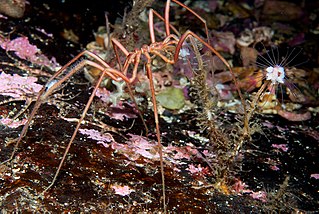 W
WNymphonidae is a family of sea spiders which has representatives in all the oceans. This family contains some 250 species, most of which are found in the genus Nymphon. Nymphonid bodies are between 1 and 15 mm long, the extent between the points of the legs reaching 150 mm. Most species are predators of hydroids.
 W
WPasternakevia is a genus of synziphosurine, a paraphyletic group of fossil chelicerate arthropods. Pasternakevia was regarded as part of the clade Planaterga. Fossils of the single and type species, P. podolica, have been discovered in deposits of the Silurian period in Podolia, Ukraine.
 W
WPhoxichilidiidae is a family of sea spiders. About 150 species are described, almost all in the genus Anoplodactylus Wilson, 1878.
 W
WPlanaterga is a clade of prosomapod euchelicerates including several synziphosurid genera and the group Dekatriata. Planaterga is defined by the opisthosoma with tergites broadest at third or fourth and lacking enlarged axial nodes, carapace with reduced genal spines, as well as somite VII with reduced appendages and microtergite.
 W
WProsomapoda is a clade of euchelicerates including the groups Xiphosura and Planaterga, as well as several basal synziphosurid genera. The clade is defined by the lack of exopods of prosomal appendage II-V in the adult instar, where in contrast the exopods of appendage II-V are well-developed in the non-prosomapod euchelicerates Offacolus and Dibasterium.
 W
WProtosolpuga carbonaria is an extinct species of solifuges, the only one of the genus Protosolpuga and the family Protosolpugidae. This Carboniferous camel spider was discovered in the Mazon Creek Formation in Illinois.
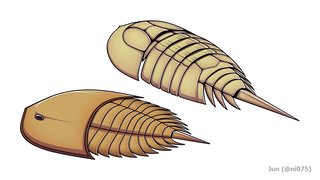 W
WPseudoniscidae is an extinct family of synziphosurine chelicerates that lived in the Silurian. Pseudoniscidae is classified inside the clade Planaterga, alongside Bunodidae and Dekatriata. Pseudoniscidae is composed by two genera, Cyamocephalus and Pseudoniscus.
 W
WPseudoniscus is a genus of synziphosurine, a paraphyletic group of fossil chelicerate arthropods. Pseudoniscus was regarded as part of the clade Planaterga. Fossils of the genus have been discovered in deposits of the Silurian period in the United Kingdom, the United States and Estonia. Pseudoniscus is one of the two members of the family Pseudoniscidae, the other being Cyamocephalus.
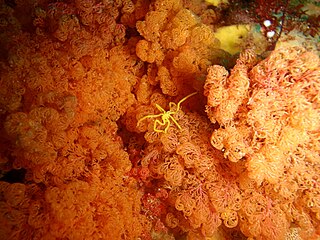 W
WPseudopallene is a genus of sea spider.
 W
WRhopalorhynchus is a genus of sea spiders in the family Colossendeidae.
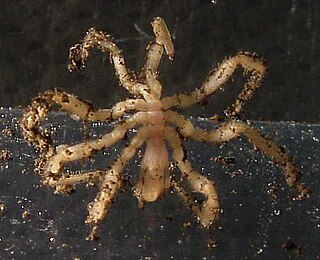 W
WSericosura is a genus of sea spiders in the family Ammotheidae. They live at depths from 106 to 3,690 meters in the ocean.
 W
WThe Tachypleini is the tribe of horseshoe crabs.
 W
WTachypleus is a genus of south, southeast and east Asian horseshoe crabs in the family Limulidae.
 W
WVenustulus is a genus of synziphosurine, a paraphyletic group of fossil chelicerate arthropods. Venustulus was regarded as part of the clade Prosomapoda. Fossils of the single and type species, V. waukeshaensis, have been discovered in deposits of the Silurian period in Wisconsin, in the United States. Venustulus is one of the few synziphosurine genera with fossil showing evidence of appendages.
 W
WWeinbergina is a genus of synziphosurine, a paraphyletic group of fossil chelicerate arthropods. Fossils of the single and type species, W. opitzi, have been discovered in deposits of the Devonian period in the Hunsrück Slate, Germany.